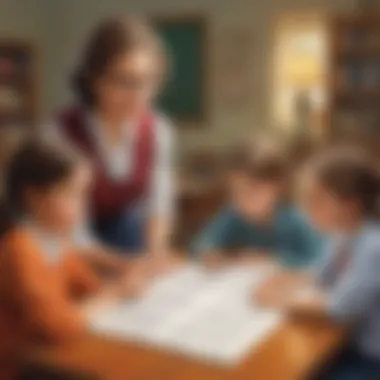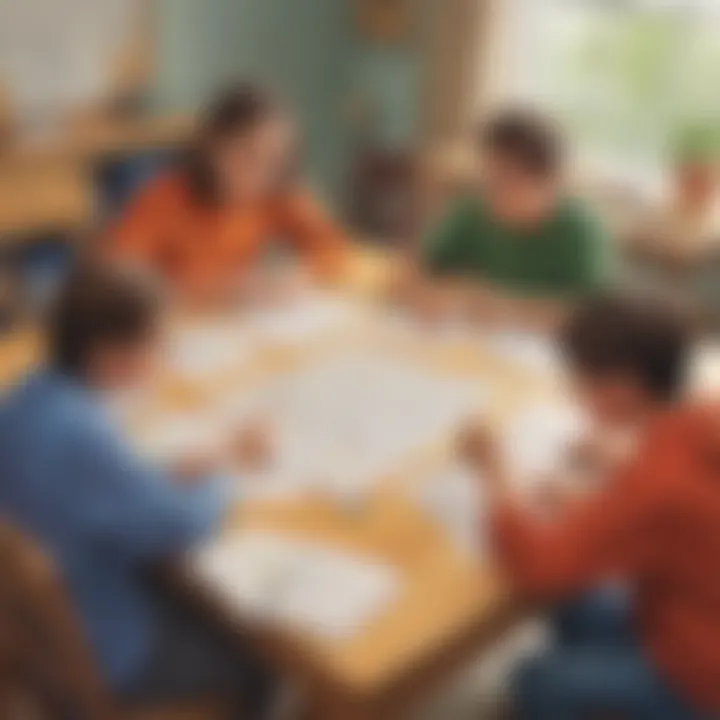Engaging Math Problems for 3rd Graders: Strategies & Insights


Intro
Exploring effective math problems for 3rd graders is vital. At this stage, children develop critical thinking and problem-solving skills. Well-designed problems engage students, making learning more enjoyable. This segment will present creative strategies for generating math problems that stimulate young minds.
Successful math problems encourage students to think deeply. They help children connect concepts with real-world applications. Moreover, engaging problems can make even complex topics more approachable. Understanding how to craft these problems is essential for parents and educators alike.
Creative Activities
Craft Ideas: Creative activities can make math engaging for 3rd graders. These ideas can serve as extensions of mathematical concepts. For example, using everyday items to create math manipulatives can enhance learning. Children can make fraction pizzas with paper plates. Layering toppings to represent various fractions makes understanding easier. Another idea is to use building blocks to illustrate addition and subtraction.
Step-by-Step Guides: Here are some activities children can replicate:
- Fraction Pizza:
- Building Blocks Addition:
- Gather paper plates and markers.
- Divide the plates into sections based on various fractions.
- Color each section with different toppings to visualize fractions.
- Use a set of building blocks.
- Assign each block a value. For example, red = 1, blue = 2.
- Have children combine blocks to find sums.
Educational Value: Engaging in these crafts develops fine motor skills while reinforcing math concepts. Children learn through play, which enhances retention. Creative activities also make learning more relatable. They take abstract concepts and turn them into something tangible.
Fun Quizzes
Quiz Topics: Quizzes can serve as an excellent tool for reinforcing skills in a fun way. Topics can range from basic addition to understanding geometric shapes. This can keep the learning experience fresh and interesting.
Question Types: A variety of question types can be used in quizzes to engage children:
- Multiple choice questions help in identifying correct answers.
- Fill-in-the-blank questions foster recall.
- True or false questions challenge critical thinking.
Knowledge Reinforcement: Through these quizzes, knowledge becomes more solidified. They allow students to review what they have learned in a non-threatening manner. Moreover, quizzes help highlight areas needing further attention.
Fact-Based Articles
Topics: Fact-based articles present a wide array of subjects. Topics can include the history of math, profiles of famous mathematicians, and practical applications of math in daily life. These articles aim to enrich the children's understanding of mathematics beyond just numbers and equations.
Engaging Content: Written in an accessible way, the articles engage young readers. Short paragraphs and clear language enhance comprehension. Visual elements, such as images or diagrams, can also support understanding.
Additional Resources: For further learning, consider exploring more resources. Websites such as Britannica offer informative articles. They can provide deeper insights into math topics. Other valuable platforms include Wikipedia for general knowledge and Reddit for community discussions on learning methods.
Crafting effective problems for 3rd graders is crucial for fostering a strong mathematical foundation.
Understanding the Cognitive Development of 3rd Graders
Understanding the cognitive development of third graders is crucial in crafting effective math problems. At this stage, children have moved beyond simple counting and basic arithmetic. They are beginning to develop more sophisticated reasoning and problem-solving skills. Recognizing these developmental phases helps educators and caregivers create math problems that are not only challenging but also relatable.
The importance of leveraging cognitive understanding allows for the development of math activities that are tailored to the learner's current abilities. This tailored approach benefits both the students' confidence and their academic progress. When children encounter math problems that align with their cognitive development, they are more likely to engage meaningfully and retain information, building a strong foundation for future learning.
Developmental Milestones
By third grade, children experience significant cognitive gains. They typically start to understand concepts such as multiplication and division, which require a grasp of not only arithmetic but also comparative reasoning. They can handle tasks that involve multiple steps and abstract thinking. For example, a third grader might solve problems like figuring out how many total apples there are if you have four baskets, each containing six apples.
Key milestones include:
- Increased Abstract Thinking: Moving from concrete objects to thinking in terms of abstract numbers and operations.
- Enhanced Problem-Solving Skills: Children learn to apply learned strategies to solve problems they encounter in various contexts.
- Improved Logical Reasoning: They begin to make deductions and justify their answers based on logical structures.
Educators can create problems that match these milestones by ensuring tasks require students to make connections between different mathematical concepts or relate them to real-world scenarios.
Mathematical Thinking Patterns
Third graders typically exhibit various mathematical thinking patterns, characterized by a mix of procedural and conceptual understanding. They start to recognize relationships among numbers and utilize various strategies to approach problems. During this stage, students often engage in explorations that allow them to discover math principles in a hands-on way.
Important aspects of their thinking patterns include:
- Pattern Recognition: Children begin to identify and extend patterns, which can lead to insights in multiplication and division.
- Strategic Use of Resources: They learn to utilize tools like number lines and counters to visualize concepts.
- Collaborative Thinking: Peer interactions enhance their learning, as they explain their reasoning to others, further solidifying their understanding.
As learners develop these thinking patterns, it's essential to present problems that encourage exploration and discussion among peers. This not only reinforces their learning but also fosters a collaborative learning environment.
Characteristics of Good Math Problems


Good math problems are essential for 3rd graders as they help build a solid foundation in mathematical thinking and problem-solving abilities. The significance of having well-defined characteristics cannot be overstated. They guide educators and caregivers in crafting problems that not only teach academic content but also encourage critical thinking and an interest in math as a subject. Through various strategies, it becomes clear how these characteristics make a difference in enhancing student's engagement and understanding.
Clarity and Precision
The clarity and precision of a math problem are crucial elements that influence student comprehension. Problems should be straightforward and easy to understand. Ambiguity can lead to confusion and frustration, which might inhibit a child's willingness to engage with math. When presenting a problem, clear language and a logical structure ensure that students grasp what is being asked without unnecessary difficulty.
For instance, instead of saying, "Tom has 12 apples, and he gives some away. How many does he have left?" a clearer version would be, "Tom has 12 apples. He gives away 4 apples. How many apples does he have now?" Precise wording paired with well-defined numbers can immediately enhance a student's ability to engage with the problem, leading them towards effective solutions.
Relevance to Real-life Contexts
Math problems that connect to real-life scenarios tend to resonate more with students. When children can relate mathematical concepts to their daily experiences, they are more likely to appreciate the value of math. Such relevance creates a context that makes abstract concepts tangible.
For example, a problem that involves grocery shopping, such as, "If you buy 3 apples at $0.50 each, how much do you spend?" speaks directly to experiences that children understand. Adding real-life elements makes math feel significant and applicable, encouraging students to see its value in their lives beyond the classroom.
Ensuring Engagement and Interest
Keeping students engaged and interested is another critical characteristic of good math problems. Problems should spark curiosity and invite exploration. A question that is either too simple or overly complex might not maintain a child's attention. Instead, the problems should present challenges appropriate to their skill level, stimulating further inquiry into the subject.
One effective strategy is to incorporate themes or interests that are familiar to the children, such as animals, sports, or games. For example, a problem like, "If a basketball team scores 4 points for each basket and they make 5 baskets, how many points do they score in total?" can capture their interest. Aligning math problems with topics within their interest can create an enjoyable learning experience and foster a more profound mathematical understanding.
Engaging and relevant math problems can captivate students' attention and enhance their willingness to learn.
In summary, the characteristics of good math problems are vital in shaping the educational experience for 3rd graders. Clarity ensures that students understand what they need to do, relevance connects math to their lives, and engagement keeps them interested in solving these problems. These elements work together to form a solid basis for enhancing young learners' mathematical proficiency.
Types of Math Problems for 3rd Graders
Understanding various types of math problems is essential for 3rd graders. At this stage, children are beginning to develop more complex thought processes. They are ready to tackle a mix of challenge and fun in their math activities. Each type of problem has unique benefits that can encourage different aspects of mathematical skills. Word problems, logic tasks, manipulative-based problems, and multi-step problems all play a crucial role in building a strong foundation for future learning.
Word Problems
Word problems serve as a powerful tool in math education. They mix real-life scenarios with mathematical questions, making it easier for children to relate. When 3rd graders work on word problems, they enhance their comprehension and analytical skills. They learn to extract relevant information from a narrative.
Benefits of using word problems include:
- Encouraging critical thinking by requiring students to analyze the situation.
- Helping students apply math concepts to real-world situations, which fosters a deeper understanding.
- Improving reading comprehension skills, which are essential for overall academic success.
When devising word problems, it's important to use clear and simple language. Moreover, connecting math concepts to interests or daily activities can greatly increase engagement.
Logic and Reasoning Tasks
Logic and reasoning tasks help children develop abstract thinking skills. These tasks usually require students to identify patterns, make connections, and draw conclusions based on given information. Engaging in logic-based problems nurtures mathematical reasoning, which is critical for future academic success.
The importance of logic and reasoning tasks includes:
- Fostering problem-solving abilities that are applicable across subjects.
- Enhancing spatial awareness and understanding of structures.
- Encouraging independent thinking as students must often work through the challenges without direct guidance.
Using puzzles or riddles can be an effective way to introduce logic tasks. These activities can challenge students while still being enjoyable.
Manipulative-based Problems
Manipulative-based problems involve physical objects that help students understand abstract concepts through tactile experience. Using tools such as blocks, counters, or interactive math games allows students to visualize numbers and operations. This hands-on approach is especially effective for younger learners.
Critical aspects include:
- Providing a concrete representation of abstract ideas.
- Allowing students to experiment and discover relationships between numbers.
- Promoting engagement through kinesthetic learning.
When creating manipulative-based problems, it is vital to ensure that the materials are age-appropriate and accessible. This method not only aids in understanding but also motivates students to explore different math concepts.
Multi-Step Problems
Multi-step problems challenge students to use multiple operations to arrive at a solution. These problems require a deeper level of reasoning and understanding, making them ideal for developing critical math skills. They also prepare students for more complex mathematics in higher grades.
The value of multi-step problems lies in:
- Teaching students how to approach a problem systematically.
- Reinforcing the idea that math is often not straightforward and may involve several steps to reach a conclusion.
- Enhancing perseverance as students work through more complex challenges.
When creating multi-step problems, clarity is key. Each step should flow logically into the next, facilitating comprehension among students. Using real-life scenarios can also enhance relatability.
In summary, exploring diverse types of math problems for 3rd graders not only aids in skill development but keeps students engaged. Each category nurtures different skills essential for their academic journey.


Creating Effective Math Problems
Creating effective math problems for 3rd graders is a crucial aspect of fostering their mathematical abilities. Effective problems engage children and make them think critically. It is important to develop problems that not only challenge the students but also resonate with their everyday experiences. This section will explore how to create math problems that meet these criteria by focusing on identifying core concepts, incorporating diverse formats, and differentiating problems based on varied skill levels.
Identifying Core Concepts
Understanding the essential core concepts in mathematics is critical for crafting effective problems. For third graders, core concepts often include addition, subtraction, multiplication, and division. It is essential to align problems with these foundational topics. By clearly identifying what concepts need reinforcement, educators can create problems that support students' learning objectives.
Benefits of identifying core concepts include:
- Targeted skill enhancement.
- Improved student confidence.
- Enhanced teacher effectiveness in measuring progress.
When teachers understand core concepts, they can formulate problems that assess these skills accurately. For instance, a problem focused on addition might involve using real-world scenarios like shopping or planning parties. This real context reinforces students' understanding of why the concept is essential.
Incorporating Diverse Problem Formats
Incorporating diverse problem formats makes mathematical learning more dynamic and exciting. Students benefit from engaging with various problem types, including word problems, visual aids, and hands-on activities. Each format can resonate differently with individual learners, catering to diverse learning styles.
Some formats to consider include:
- Word Problems: These encourage reading comprehension alongside problem solving.
- Visual Representations: Using charts or diagrams helps visual learners grasp math concepts.
- Manipulative Tools: Physical objects can enable hands-on learning, making abstract concepts tangible.
By using a mix of formats, educators can maintain students’ interest and promote deeper understanding. Each format challenges students to apply their knowledge and enhances retention.
Differentiating Problem Types for Varying Skill Levels
Not all students learn at the same pace or in similar ways. Differentiating problem types based on varying skill levels is essential in meeting the needs of every learner. This ensures that all students, whether needing extra help or seeking more challenge, can engage meaningfully with math problems.
Strategies for differentiation include:
- Adjusting Complexity: Simple problems for those just grasping basic concepts and more complex, multi-step problems for advanced students.
- Grouping Students: Create small groups based on skill level, allowing targeted instruction.
- Choice in Problems: Providing several problems at various difficulty levels allows students to choose based on their confidence.
Using these strategies not only fosters a more inclusive classroom but also encourages a growth mindset among students. They learn to see challenges as opportunities for growth rather than obstacles.
Effective math problems are not merely tasks to complete, but are tools to enhance understanding, foster critical thinking, and promote a love for learning.
Implementing Math Problems in the Classroom
Implementing math problems within the classroom framework is a pivotal aspect of fostering mathematical understanding among third graders. This stage of education allows for the introduction of problems that engage students actively, helping them apply their mathematical knowledge in meaningful ways. The choice of problems can significantly influence how students perceive and engage with mathematics. Thus, careful thought regarding implementation strategies is essential.
Collaborative Problem Solving
Collaborative problem solving involves students working together to tackle math problems. This approach not only promotes a deeper understanding of mathematical concepts but also enhances social skills and communication. When students engage in discussions about their thought processes, they learn to articulate ideas clearly and listen to diverse perspectives.
In a collaborative setting, the following elements are vital:
- Peer Learning: Students can learn from one another. They often explain concepts to their peers in ways that resonate better than traditional instruction.
- Shared Responsibility: When solving problems as a group, students feel a shared sense of accountability. This motivates them to participate actively.
- Critical Thinking: Working with others encourages students to think critically. They evaluate various methods to solve problems, fostering adaptability in their approaches.
Incorporating collaborative strategies can lead to more profound comprehension and retention of math concepts in students.
Using Technology to Enhance Engagement
Technology plays a crucial role in modern education. Integrating tech tools can transform traditional problem-solving experiences into interactive learning opportunities. Various tools can help in achieving higher engagement levels among students:
- Interactive Math Software: Such as Khan Academy, offers instant feedback and allows students to practice at their own pace.
- Online Collaboration Tools: Platforms like Google Classroom facilitate communication and collaboration, making it easier for students to work together on problems.
- Gamified Learning Apps: Programs like Prodigy Math can make math problems enjoyable by turning them into games.
These tools cater to various learning styles, ensuring every student is engaged in their math learning journey. It is essential to provide guidance on the use of these tech resources to maximize their benefits.
Assessing Understanding through Problem Solving
Assessment is a critical component in understanding how well students grasp mathematical concepts. Evaluating students through problem-solving allows educators to witness their thought processes in real time. This method offers several benefits:
- Real-world Application: By solving relevant problems, students demonstrate their ability to apply math skills outside the classroom.
- Identifying Strengths and Weaknesses: Educators can pinpoint areas where students excel or struggle, allowing for targeted support.
- Encouraging Self-Assessment: Students can reflect on their strategies and outcomes, fostering a mindset of continuous improvement.
Regular assessments through problem-solving not only measure academic performance but also nurture a culture of growth and resilience in learning.
Implementing effective math problems in a collaborative classroom ensures enhanced engagement and deeper understanding of fundamental concepts.


Resources for Finding Good Math Problems
Finding suitable math problems for 3rd graders is crucial. These problems should support their cognitive development and foster critical thinking skills. Various resources available to educators and parents can offer valuable insights. Utilizing different formats for problem presentation can lead to enhanced engagement and understanding. Moreover, these resources can help in capturing a child's interest in mathematics, thereby contributing to a more positive learning experience.
Books and Printed Materials
Books remain a timeless resource for finding math problems. They provide structured exercises and often include solutions or explanations. Several classics serve elementary math education well. Titles such as "Math in Focus: Singapore Math" and "Helping Your Child Learn Mathematics" by the US Department of Education can be particularly useful. These resources complement hands-on practice and can become a part of a child's regular study routine.
Moreover, printed workbooks specifically designed for 3rd graders often have a variety of problems, from word problems to logic tasks. They usually come with answers, giving parents and educators the ability to check progress easily. Here are some benefits of utilizing books:
- Varied Problem Types: Many books include different kinds of problems, making practice more fun.
- Structured Learning: Organized chapters allow for gradual skill development.
- Accessibility: Available at libraries or bookstores, they are easy to access.
Online Platforms and Websites
Digital platforms have transformed the way educational materials are accessed. Websites like Khan Academy and IXL offer a plethora of math problems suitable for 3rd graders. These platforms frequently update their content, ensuring that learners have access to current and relevant problems. The interactive nature of these websites can keep children engaged longer than traditional methods. Additionally, some sites offer personalized learning experiences that adapt to the child's skill level.
Benefits include:
- Instant Feedback: Online platforms often provide immediate correction and explanations, promoting a better understanding of mistakes.
- Interactive Learning: Games and interactive modules enhance engagement and make learning enjoyable.
- Resource Variety: Many sites combine videos, quizzes, and practice problems, offering a holistic educational approach.
Math Apps and Games
Technology also extends to educational applications that can be downloaded on tablets and smartphones. Apps like Prodigy Math and Cool Math Games make learning math exciting through gamification. These platforms often include rewards to encourage continued practice, which can be particularly motivating for young learners. Importantly, these apps can foster independent learning, allowing children to explore math at their own pace.
The advantages of utilizing math applications are numerous:
- On-the-go Learning: Children can practice math anytime and anywhere.
- Engagement Through Gamification: The use of game-like elements helps sustain interest and motivation.
- Tailored Learning Experiences: Many apps assess progress and adjust challenges to suit the user’s level.
Exploring different resources for math problems fosters a diverse and engaging learning environment. Utilizing books, online platforms, and educational apps results in a comprehensive approach to math education for 3rd graders.
Evaluating the Effectiveness of Math Problems
Understanding how to evaluate the effectiveness of math problems is critical in fostering a productive learning environment for third graders. This section underscores the importance of assessing math problems, as it directly influences students' comprehension and engagement. Evaluating effectiveness encompasses various criteria, including clarity, relevance, and challenge level. Educators must consider these factors to ensure that the problems are not merely exercises but tools for developing key problem-solving skills. The benefits of effectively evaluated problems include improved student performance, enhanced critical thinking, and greater motivation to learn.
Criteria for Assessment
When assessing the effectiveness of math problems, several specific criteria come into play. Here are some of the key points to consider:
- Clarity: Problems should be straightforward and free of ambiguity. Proper phrasing ensures students can focus on solving instead of deciphering the question.
- Appropriate Difficulty: Problems should be challenging but not overwhelmingly so. They should encourage students to stretch their skills while remaining accessible.
- Relevance: Situating math problems in real-life contexts helps students relate to the content, making learning more applicable and meaningful.
- Variety of Formats: Using different types of problems, such as word problems, manipulative tasks, and multi-step problems, caters to varying learning preferences and keeps students engaged.
- Feedback Potential: Good problems allow for opportunities to offer feedback, guiding students on their learning journey.
Efficient assessment criteria aid in recognizing the quality of math problems. This understanding leads to more effectively curated problem sets that align with educational goals.
Gathering Feedback from Students
Gathering feedback from students plays a significant role in evaluating the effectiveness of math problems. Students' insights provide valuable information about their learning experiences. Here are a few methods to collect this feedback:
- Surveys and Questionnaires: Quick surveys can gauge students’ perspectives on the difficulty and clarity of the math problems they encounter.
- Class Discussions: Open dialogues allow students to express their thoughts, helping educators identify which problems resonate well and which do not.
- Exit Tickets: At the end of lessons, students can write down what they felt about the problems they worked on, offering immediate feedback for instructors.
- Observation: Careful observation during problem-solving sessions can reveal how students approach challenges, indicating problem effectiveness.
Gathering feedback ensures that the learning process is a two-way street, ultimately enhancing the quality of assignments.
Incorporating and reflecting on student feedback helps tailor future math problems, ensuring that they cater to the needs and experiences of third graders.
Next Steps in Math Learning for 3rd Graders
Understanding the next steps in math learning for 3rd graders is crucial for fostering their academic growth. This stage serves as a bridge to more advanced concepts. As students build upon their foundational skills, it is vital that they encounter new challenges tailored to their cognitive development. The objectives at this level include not only introducing complex mathematical ideas but also ensuring learners can apply their skills in real-world scenarios.
By focusing on transitional phases in math education, educators can provide a structured approach that prepares students effectively. This preparation is beneficial as stronger skills provide students with enhanced confidence, making them more eager to confront more difficult problems in future grades.
Transitioning to Advanced Concepts
Transitioning to advanced concepts is about introducing new mathematical ideas. In 3rd grade, children start exploring multiplication, division, and fractions. These concepts can feel overwhelming if not approached properly. Hence, it is essential to build upon what students have already learned. For instance, building on their understanding of addition and subtraction can make introducing multiplication easier.
Here are some strategies to aid in this transition:
- Use Visual Aids: Graphic organizers, number lines, and charts can clarify new concepts.
- Create Connections: Relate new concepts to real-life situations. For example, discussing fractions using slices of a pizza can make learning engaging and relevant.
- Encourage Peer Learning: Group work helps students learn from each other. It also creates a supportive environment.
Advanced concepts should not feel like a leap. Instead, they should feel like a natural progression of skills learned previously.
Continuous Skill Development
Continuous skill development is vital for maintaining and enhancing mathematical proficiency. As 3rd graders progress, they need regular opportunities to practice their skills. This prevents skill decay and solidifies their understanding. Frequent practice helps in establishing a robust foundation for future learning.
To promote continuous development, consider the following approaches:
- Daily Math Activities: Short, daily exercises can keep skills fresh. Activities such as mental math games or quick problem-solving sessions can be effective.
- Integrated Learning: Incorporating math into everyday activities allows children to see its relevance. Cooking can provide practical examples of measurement and fractions.
- Regular Assessments: Frequent evaluation can identify areas needing improvement. This way, educators can tailor instruction to better meet each student's needs.







